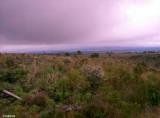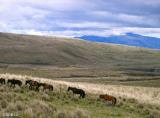Tourism in the protected area Pasochoa
Tourism in the protected area Pasochoa
CI
Pasochoa
Wildlife Refuge
Pasochoa Park has a great variety of wildlife. It is located within the inactive volcano Pasochoa caldera 4210 m, and has an extension of 500 hectares.
Access to the park is from Amaguaña or Cotogchoa.
The refuge protects a unique patch of forest in the inter-Andean alley, which, thanks to its difficult access (inside the caldera) has been saved from being destroyed.
Here it is possible to undertake both an extreme adventure excursion and a quiet walk to enjoy the Andean biodiversity. You can climb the rocky volcano or walk on comfortable and well marked trails, and spend the night at the camping site.
Volcán Pasochoa (4.210 m)
It is a dormant volcano. Its caldera measures 2 kilometers in diameter and opens to the west. It has the shape of a large hemicycle on whose walls and bottom grows the Andean forest that is protected by the refuge, between the Santa Ana and Sambache ravines. From these heights flows the water that will later form the San Pedro River, a tributary of the Guayllabamba.
Trails and biodiversity of the Andean forest
These forests are found between the páramos and the agricultural and urban areas of the lower parts. They are characterized because several hours a day they are visited by the mist; Although it does not always rain, they maintain extraordinary humidity. Cloud forests present a complex structure with several levels or floors, in all of which the abundance of epiphytic plants stands out, that is, those that live on other plants without harming them.

Other Natural o Protected Areas and Spots
Galapagos - Llanganates - Ilinizas - Chimborazo - Sangay - Yasuni - Cuyabeno - Machalilla - Cotopaxi
Photo: Pasochoa
Pichincha - Ecuador
Cotopaxi Highlands Paramo Protected Area
Horses Cotopaxi National Park
The Andean forest of the caldera is the last remnant of the ancient forest in the Uyumbicho area, described by the Spanish conquistadors as follows: “…a sea of trees stretched between the Tiopullo knot, the leaks of the old common south of Quito (Guajaló) and the proximities of the towns of Cumbayá and Tumbaco”. By the 17th century, most of the forests had already disappeared, since the wood from trees such as the myrtle, the quishuar, the cedar, the walnut and the sisín, among others, was used to build and heat the homes of Quito: "The mountains of Uyumbicho, from which said city used to be supplied [are] felled and dismantled, in such a way that there [...] is not an important pole for the said buildings" (Hidalgo Nistri, Fernando. Los ancient forest landscapes of Ecuador.
A reconstruction of its first ecosystems. (Quito, Ediciones Abya-Yala, 1998.) At the beginning of the 20th century, the farms that surrounded the Pasochoa caldera and that had belonged to religious communities, became property of the State, which turned them over to the Ministry of Health for manage them. The declaration of Pasochoa as a protected area is due to the particular interest of the Ecuadorian scientist Fernando Ortiz Crespo (1942 - 2001); In 1982, upon noticing the existence of a very special forest within the collapsed caldera that required active protection, he proposed to this State Portfolio the declaration of Pasochoa as "Protective Forest". For almost two decades the area was managed by Fundación Natura, a private conservation organization.
A walk through the forest paths shows the biodiversity of the refuge: several species of orchids, huaycundos and umbrellas, a plant with huge leaves that grows near the water. There are also trees such as alders, pumamaquis, myrtles, cedrillos and palms, and shrubs such as little shoes, colcas and chilcas. In the forest there are also many plants that are used by humans as medicine or food: horse sucks, nettle, plantain, blackberry and tocte. In the upper part is the páramo of pajonal mixed with small bushes of romerillo and mortiño.
In the most protected areas are the famous paper trees or pantzas.
Although the refuge is small, there are large mammals such as the puma, the white-tailed deer and the páramo wolf. There are also smaller mammals such as marsupial mice and opossums, rabbits and Andean weasels or chucuris. El Pasochoa is a very good place to see birds, especially hummingbirds such as the Sword-billed, Brilliant Sunbeam and the Long-tailed Puffin. You can also see quilicos, curiquingues, Andean guans, turtle doves, woodpeckers, huiracchuros, red-crested cotingas and a large number of tanagers. Among the amphibians there are glass frogs crouching in the branches of trees, and marsupial frogs, which prefer to live inside bromeliads.
From the west you can see its collapsed caldera, covered by a dense forest, and from the eastern slope its steep cliffs are evident. In this Refuge you can make ascents to Pasochoa and walk the trails in which you can observe flora and fauna of the Andean forest, among which the great variety of birds typical of this ecosystem stands out. The activities allowed in the protected area are hiking, photography and camping.
Localidad:
Uyumbicho: San Pedro de Pilopata
Neighborhood/Sector: San Pedro de Pilopata
Tourist Attraction: Access trails to the crater of the Pasochoa Volcano
Fuentes: areasprotegidas.ambiente.gob.ec; goraymi.com
- Latacunga is the capital of the Cotopaxi province. Latacunga is famous for its Hallullas and cheeses. One of the typical foods are chugchucaras.
- The Los Ilinizas Ecological Reserve is in the province of Cotopaxi near Sigchos.
- It is located next to the Cotopaxi National Park.
- City of flowers and fruits, also known as the city of the "Tres Juanes", and the capital of the Tungurahua province. Typical foods are "llapingachos", guinea pigs and in November the famous "colada morada".
- You can also enter the park with the train from Quito and Ambato.





